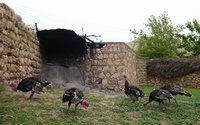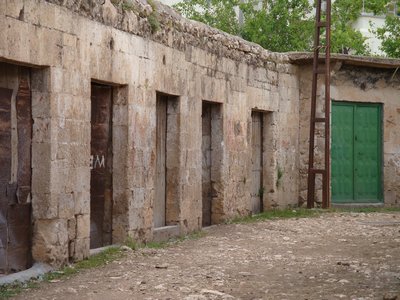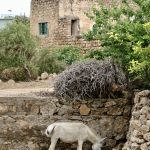The road to Dargeçit, the old Suryani Kferboran northeast of Midyat, is in a shocking state. Or at least I presume that it still is, given how it was when I was bouncing along it last May as I did my best to take in as much of the Tur Abdin as I could in a few days. The reason for the shocking state and the resulting filthy looks the taxi driver cast in my direction? Well, while the Ilısu Dam project is usually talked about in the same breath as Hasankeyf, the beautiful town on the Tigris that it threatens to drown, the reality is that the dam will be built closer to Dargeçit. In consequence the road there is being upgraded which means bumps and dust for mile upon mile for the foreseeable future.
To be honest I’d never heard of Dargeçit but I had in my possession a book on the Tur Abdin by Hans Hollerweger and in it there were pictures that made it look as if it was somewhere worth trying to squeeze into the itinerary. Already I’d been to Anıtlı, the old Suryani Hah, which boasts not just a magnificent sixth-century church with a unique square super-structure but also enough other ruins in the surrounding fields to make it obvious that it was once a place of some significance, not the half-forgotten village it is now. With the photographer Rebecca Erol, I’d also dropped in on İzbırak, the Suryani Zaz, where one ancient priest had returned from Sweden to look after the abandoned church, tacking on living quarters of somewhat questionable architectural quality, then piling up archaeological finds from the site in the undercroft.
Both Hah and Zaz were small places, Cotswoldy in their appeal, golden-hued and rustic. Dargeçit, on the other hand, was a real town, and not, at first sight, an especially appealing one either. The driver didn’t seem to know much about it or at least he certainly didn’t know where the churches I wanted to see were, but we quickly picked up a couple of young men with time on their hands who could point them out to us. Actually, it was a bit like going in search of the old Greek Orthodox and Armenian churches of İstanbul. Like them, the Dargeçit churches ducked down behind high walls, their presence given away only by their bell towers. Alas, there were no handy caretakers to respond to our knocks.
The young men shrugged hopelessly. Then they steered us away from the modern town towards the Safa neighbourhood at the bottom of a hill and across a stream bereft of water and used as a rubbish dump. There it was that we found the Dargeçit of the pictures, a virtually abandoned place of lovely old stone houses, very Cappadocian in their appearance but with plenty of clues in the scrawled PKKs and APOs on the walls to remind us how far east we’d actually come.
Demokrasi Sokak (Democracy St) turned out to be a street of boarded-up shops wending its way towards a field hedged with drystone walls and nurturing the sort of soot-blackened fırın (communal oven) I’d seen in Diyarbakır, the sort that rather resembles an old-fashioned top-loading oven into which bread can be dropped, then pressed against the walls to bake. The field was full of turkeys and overlooked by tall trees full of jackdaws. Rundown, neglected and filthy, the mahalle was nevertheless crying out to be given a tourism makeover. Small shops, I thought. Craft workshops. Cute little cafes. It could all be so charming, and no one would even need to be displaced given the paucity of residents. Just then a woman passed by and paused to size me up. “Where are you from?” she asked, then went on her way, her curiosity seemingly sated by the standard “I’m from England but live in Nevşehir” response.
By now the taxi driver was far ahead of me on his way back to the car. I longed to linger. I cursed the cost of running a car in Turkey. But there was nothing for it but to follow him.
Later I read what Wikipedia had to say about Dargeçit. In the English it says that most of the Suryani population finally left after the murder of the mayor, Andreas Demir Lahdik, in 1979. In the Turkish it says merely that some of the Suryanis emigrated to Europe in search of a better life after the First World War. Lahdik doesn’t get a look in.
Written: 25 January 2012


